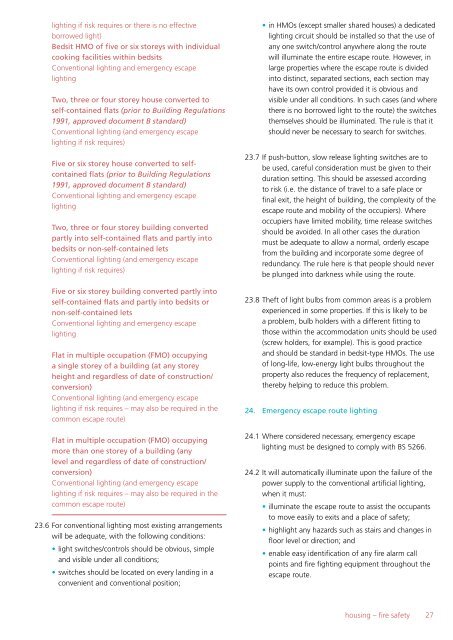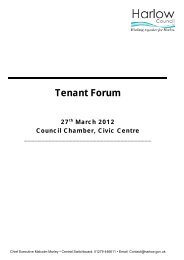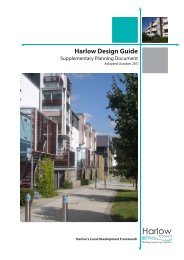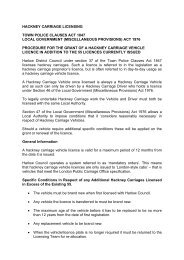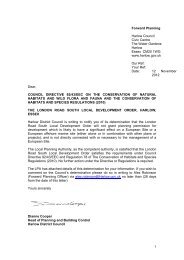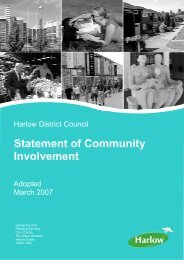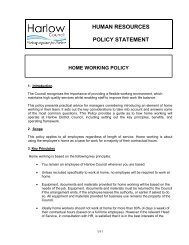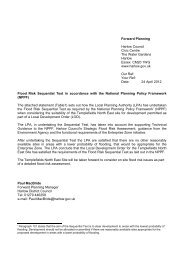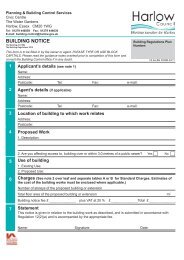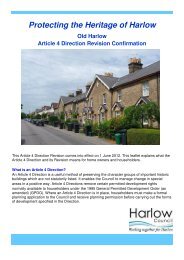HMO fire safety guidance - Harlow Council
HMO fire safety guidance - Harlow Council
HMO fire safety guidance - Harlow Council
Create successful ePaper yourself
Turn your PDF publications into a flip-book with our unique Google optimized e-Paper software.
lighting if risk requires or there is no effective<br />
borrowed light)<br />
Bedsit <strong>HMO</strong> of five or six storeys with individual<br />
cooking facilities within bedsits<br />
Conventional lighting and emergency escape<br />
lighting<br />
Two, three or four storey house converted to<br />
self-contained flats (prior to Building Regulations<br />
1991, approved document B standard)<br />
Conventional lighting (and emergency escape<br />
lighting if risk requires)<br />
Five or six storey house converted to selfcontained<br />
flats (prior to Building Regulations<br />
1991, approved document B standard)<br />
Conventional lighting and emergency escape<br />
lighting<br />
Two, three or four storey building converted<br />
partly into self-contained flats and partly into<br />
bedsits or non-self-contained lets<br />
Conventional lighting (and emergency escape<br />
lighting if risk requires)<br />
Five or six storey building converted partly into<br />
self-contained flats and partly into bedsits or<br />
non-self-contained lets<br />
Conventional lighting and emergency escape<br />
lighting<br />
Flat in multiple occupation (FMO) occupying<br />
a single storey of a building (at any storey<br />
height and regardless of date of construction/<br />
conversion)<br />
Conventional lighting (and emergency escape<br />
lighting if risk requires – may also be required in the<br />
common escape route)<br />
Flat in multiple occupation (FMO) occupying<br />
more than one storey of a building (any<br />
level and regardless of date of construction/<br />
conversion)<br />
Conventional lighting (and emergency escape<br />
lighting if risk requires – may also be required in the<br />
common escape route)<br />
23.6 For conventional lighting most existing arrangements<br />
will be adequate, with the following conditions:<br />
• light switches/controls should be obvious, simple<br />
and visible under all conditions;<br />
• switches should be located on every landing in a<br />
convenient and conventional position;<br />
• in <strong>HMO</strong>s (except smaller shared houses) a dedicated<br />
lighting circuit should be installed so that the use of<br />
any one switch/control anywhere along the route<br />
will illuminate the entire escape route. However, in<br />
large properties where the escape route is divided<br />
into distinct, separated sections, each section may<br />
have its own control provided it is obvious and<br />
visible under all conditions. In such cases (and where<br />
there is no borrowed light to the route) the switches<br />
themselves should be illuminated. The rule is that it<br />
should never be necessary to search for switches.<br />
23.7 If push-button, slow release lighting switches are to<br />
be used, careful consideration must be given to their<br />
duration setting. This should be assessed according<br />
to risk (i.e. the distance of travel to a safe place or<br />
final exit, the height of building, the complexity of the<br />
escape route and mobility of the occupiers). Where<br />
occupiers have limited mobility, time release switches<br />
should be avoided. In all other cases the duration<br />
must be adequate to allow a normal, orderly escape<br />
from the building and incorporate some degree of<br />
redundancy. The rule here is that people should never<br />
be plunged into darkness while using the route.<br />
23.8 Theft of light bulbs from common areas is a problem<br />
experienced in some properties. If this is likely to be<br />
a problem, bulb holders with a different fitting to<br />
those within the accommodation units should be used<br />
(screw holders, for example). This is good practice<br />
and should be standard in bedsit-type <strong>HMO</strong>s. The use<br />
of long-life, low-energy light bulbs throughout the<br />
property also reduces the frequency of replacement,<br />
thereby helping to reduce this problem.<br />
24. Emergency escape route lighting<br />
24.1 Where considered necessary, emergency escape<br />
lighting must be designed to comply with BS 5266.<br />
24.2 It will automatically illuminate upon the failure of the<br />
power supply to the conventional artificial lighting,<br />
when it must:<br />
• illuminate the escape route to assist the occupants<br />
to move easily to exits and a place of <strong>safety</strong>;<br />
• highlight any hazards such as stairs and changes in<br />
floor level or direction; and<br />
• enable easy identification of any <strong>fire</strong> alarm call<br />
points and <strong>fire</strong> fighting equipment throughout the<br />
escape route.<br />
housing – <strong>fire</strong> <strong>safety</strong> 27


